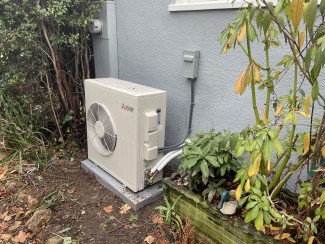Heat pumps are a critical tool for cutting climate pollution. Unfortunately, typical electric rates can effectively penalize households that install them. New rates for winter heating can help address the problem, particularly for energy-burdened households.
Regulators in Massachusetts recently approved a utility’s plan to offer households with heat pumps a lower electric rate during the winter and to offer a further discounted rate for low-income households. This approach from Unitil, which serves a small portion of the commonwealth, should be improved upon and replicated across the country as regulators consider similar proposals from other utilities.
To maximize benefits for energy-burdened households and the entire electric system, utilities and their regulators should consider several broad principles and goals as they consider new rates to support heat pumps:
- Maintain a price signal for efficient heating, especially during times of peak demand;
- Limit participation to households with heat pumps;
- Reduce energy burdens for low-income households; and
- Get efficient heat pumps to low-income households.
Opportunities to improve differing rate proposals
The actual cost of distributing electricity to households is usually lower in the winter, in part because utilities build their systems to meet the highest electric demands, which are most often on hot summer days. With typical electric rates, households that use heat pumps for winter heating are often being overcharged relative to their costs to the electric system. Unitil’s plan, approved late last month, will offer households with heat pumps a significantly lower volumetric distribution rate—the distribution cost per amount of electricity used—during the winter months. The company will offset some of that rate reduction with a slightly higher fixed charge each month, but a household using a heat pump for space heating will still save a lot of money, potentially hundreds of dollars a year. Unitil will also offer participating low-income households a further 40% discount on that rate.
National Grid, another Massachusetts utility, took a different approach for its proposed optional rate, eliminating the volumetric distribution rate entirely in favor of a fixed charge for any participating household, regardless of the heating source. Under National Grid’s proposal, low-income households wouldn’t be able to apply a discount if they chose that rate option. In Minnesota, Xcel also has proposed an electric space heating rate. Like Unitil, Xcel is proposing a lower volumetric rate in the winter, but it would vary the rate based on the time of day and automatically apply a discount for low-income households.
How each proposal for new rates lines up with the four principles above has significantly influenced support or opposition: nobody commented in opposition to Xcel’s proposal in Minnesota, Unitil’s proposal received support from the Massachusetts Department of Energy Resources, but National Grid’s proposal has been opposed by many stakeholders in the commonwealth. Evaluating the three proposals based on the four principles listed above, it becomes clear why the Unitil and Xcel plans were better received than National Grid’s plan:
- Maintain a price signal for efficient heating, especially during times of peak demand. While there is usually plenty of room for new electric demand in the winter, that doesn’t mean we should incentivize inefficient use and waste. Unitil’s proposal would reduce the volumetric rate without eliminating it entirely, helping maintain a price signal for efficient electricity consumption. Xcel goes even further in the right direction, adjusting rates upward during times of high electricity demand and downward when there’s less electricity use (known as a “time of use” rate), providing an incentive for shifting use away from the most expensive hours of the day. National Grid’s proposal to charge a flat distribution fee regardless of consumption does not maintain that price signal.
- Limit participation to households with heat pumps. Not all electric heating is efficient—heat pumps are, but electric resistance is not. Utilities should limit participation in electric heating rates to households that have a heat pump. This is where Unitil’s proposal is the best of the lot. Xcel’s would enable participation for any electric space heating, not just heat pumps, which could incentivize inefficient electric resistance heating. National Grid’s proposal also moves in the wrong direction, enabling participation by any household regardless of heating fuel, a recipe for simply subsidizing inefficient electric use.
- Reduce energy burdens for low-income households. Too many households are struggling to afford their energy bills, often with disastrous consequences. Any rate design proposal should lower energy burdens for low-income households. Unfortunately, National Grid wouldn’t allow any low-income household participating in its proposed optional rate to also receive a discount for energy assistance. This contributed to vigorous stakeholder opposition to its proposal. Again, Unitil’s proposal was better, allowing low-income households to participate in the heat pump rate and receive the 40% discount on top of that. Xcel’s proposal has one feature that is even better: applying the discount for energy assistance automatically for all eligible low-income households, with a goal of keeping energy burdens below 4%.
- Get efficient heat pumps to low-income households. Admittedly this last principle isn’t rate design, but it is equally important and intertwined. If only wealthier households are adding heat pumps, then a reduced winter electric rate for households with heat pumps will be regressive, with lower-income households paying higher rates. So any heat pump rate has to be paired with a robust program to fund installation of efficient heat pumps for low-income households. And those low-income households with heat pumps should automatically be given the heat pump rate and energy assistance to ensure their overall energy burden doesn’t increase.
The recent proposals in Massachusetts and Minnesota are among the earliest for new optional rates to account for the differing costs and benefits of electric heating, but they won’t be the last. The Colorado legislature has mandated a proposal from utilities to encourage heat pump adoption in coming years, and more states are expected to do the same. The early proposals offer important lessons for other utilities and state regulators on the right—and wrong—ways to encourage efficient and affordable electric heating.

